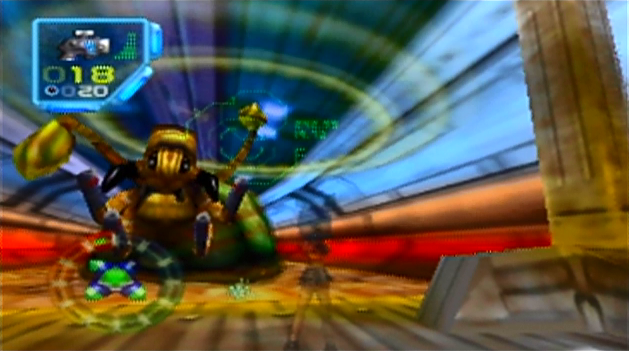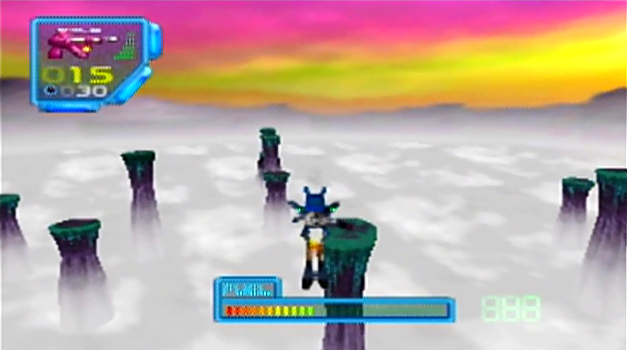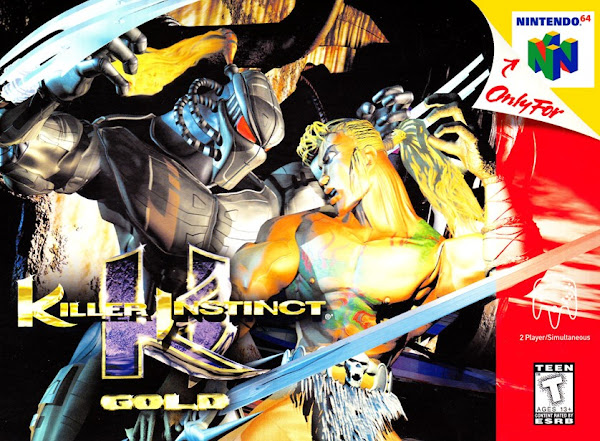
|
|
Released on October 11, 1999 in North America by Rare,
Jet Force Gemini is a bug-bursting, interstellar third-person
shooter
|
Many of Nintendo's right-hand developers either jumped ship to Sony during
the PlayStation/Nintendo 64 era, or at least put more energy and resources into
Nintendo's competitor. With such prestigious companies as SquareSoft suddenly
leaving a huge vacuum in the catalogue for the Nintendo 64, someone had to step up--and that
someone was Rare. The quirky British outfit had already made 16-bit gaming history with
their Super Nintendo Donkey Kong Country titles. Now, in this 64-bit era, there were long periods where Rare put Nintendo's console on their back. As much as I
missed Square, incredible titles like
GoldenEye 007,
Diddy Kong Racing, and
Banjo-Kazooie not only eased the pain, but
helped put Rare and the Nintendo 64 itself into legendary status. By 1999, I eagerly
awaited and marked off my calendar for any title Rare announced, and my
excitement reached a fever pitch with that fall's space action extravaganza,
Jet Force Gemini. However, critical praise for the game was slightly muted.
Sure, it's good, they said,
but not quite as good as Rare's previous work...I thought the
critics were dunderheads. I loved
Jet Force Gemini, finding it to be one
of my favorite games I'd ever played. Critics complained about game length and
backtracking, but I eagerly played through to the final credits, collecting and
completing everything the game offered. But that was 25 years ago. For that 25th anniversary, I've played through it
again. How does
Jet Force Gemini hold up?

|
|
It's not only in Dolby Surround...
|

|
|
...It's in Widescreen!
|
One thing becomes immediately clear:
Jet Force Gemini still looks
great. Rare made real effort to make the game's many planets feel like real,
alien worlds. Textures are higher resolution than most other 64 games, so rocks,
trees, grass, and dirt all look wonderful. The bright, colorful planets range
from a waterfall-pocked jungle world, to a blue planet full of craters and giant
mesas, to a purple rock world full of towering bluffs and cloud-piercing
hoodoos, to many, many more. Some levels also take place on enormous,
bug-filled starships, featuring unique, singular architectural design. There's
nothing generic here--this is late 90s excellence. Even better,
Jet Force Gemini helps restore the lost Super Nintendo art of a
"background." Many (but certainly not all!) Nintendo 64 games just feature fog
in the far distance, but
Jet Force Gemini's worlds feature 360-degree backgrounds that stimulate the imagination, just like
the ones in the Super Nintendo (and NES) do. I love looking off in the distance in this game, and imagining what's going on in those distant backgrounds. Also, environmental effects like
lighting and rain and even reflections are top notch for the console. Explosions and frequent
geysers of bug guts look great. Character designs are memorable and top-of-the-line--one of the player characters is even a dog on tank treads with a gun mounted to his
back--it's fantastic. Somehow, with all of this,
Jet Force Gemini runs smoothly, with a
framerate that rarely slows down, even when a multitude of enemies are raining a hail of bullets and explosions. The graphics aren't quite perfect,
though. If the player hugs a wall in certain tight hallways and tunnels, there is sometimes clipping, meaning the edge of the screen beyond the wall will be visibly black, and the rest of the hallway or tunnel might be visible beyond that.
This certainly doesn't hurt gameplay in any way, but does slightly effect the
immersion factor.

|
|
Look ma, (these bugs have) no hands!
|

|
|
In Nintendo 64 games, I DO go chasing waterfalls. Actually, I'd
like to make a coffee table book called
Nintendo 64 Waterfalls because they are one of my favorite
things.
|
While
Jet Force Gemini's graphics are top notch, the sound is even
better. Rare, far ahead of the curve, presents this game in surround sound,
meaning that bullets whiz by and ding off walls in a way that feels shockingly
realistic for the Nintendo 64. The soundscapes here are extremely immersive,
with said bullets whizzing, bugs shrieking and screaming, waterfalls roaring,
footsteps falling. There's no voice acting here, but that's a timeless
blessing, as Rare instead utilizes the delightful "chirpy" voices they were
known for at the time. However, despite the excellence in sounds effects, the
star of the show here is an all-time great video game score by Robin Beanland
(with assists by Graeme Norgate and
Alistair Lindsay). Beanland would go on to win a BAFTA award for his work on
Conker's Bad Fur Day the next year, but the Jet Force Gemini soundtrack is his
magnum opus. This is big, bombastic, blood-pumping music that any great action
film would be more than proud to feature. In fact, Beanland's music here is
better than what's heard in the vast majority of not just action films, but
cinema in general. It's that good. Every level rolls out a new, thrilling,
mind-blowing theme, and it's all done at such a high sample rate, it feels
like a real orchestra. It's tough to argue that any game for the Nintendo 64
has a better soundtrack, even the console's two incredible Zelda titles. It's
just that good.

|
|
My second 64-bit graphical obsession is space. I love space in
Nintendo 64 games, and Jet Force Gemini has more of it than
any other.
|

|
|
This game also makes an art out of caves--many other Nintendo 64 developers would have to lower the detail and slather this cave in fog,
but not Rare!
|
The game's story could be generic--a bug army, led by the evil big bug,
Mizar, has invaded the galaxy, and is capturing and enslaving the local,
teddy-bear like race, the Tribals--however, it is full of the typical Rare
quirk, charm, and humor, and goes in some delightfully strange directions. The
player begins the game as Juno, a member of the recently destroyed Jet Force.
Juno, along with his sister, Vela, and dog, Lupus, are the only survivors of
the Jet Force Fleet's destruction at the hands of Mizar. Eventually, the
player unlocks Vela and then Lupus, and must use all three to wipe out the bug
army, the four enormous, disgusting boss bugs (including Mizar), and save the
Tribals.

|
|
Hey Tribals...what if you tried saving yourselves?
|

|
|
Adding to the awesome graphic design, each character has their own
unique logo
|
The gameplay comes from a third person perspective. One of the main
objections lobbed at
Jet Force Gemini involved its control scheme. Movement is
handled through a blend of the joystick and C-buttons. Up and down on the
joystick make the player character go backward or forward, while left and right
cause the character to turn. The left and right C-buttons are for
side-stepping, while up on the C-buttons is for jumping, and down is for
crouching. The classic Nintendo 64 trigger is for firing, while the R-button
(the right shoulder button) brings up an aiming cursor, and puts the gameplay
into a pseudo-first person mode. From this first person mode, the player can
not only aim, but look around with the joystick--and even move with the
C-buttons, where up and down now move the character backward and
forward.

|
|
Oh no, new things are scary! Also, the Abandoned Spacestation level
is scary. |

|
|
That's strange, the control system is somehow not preventing me
from running and gunning these bugs into squishy little pieces
|
Yes, the control system is different, but that doesn't make it bad. It
does take a minute to get used to because it's unique, especially in a twin
joystick world. However, after nearly 25 years of not playing this game, I
picked up my controller and found the controls to be second nature, just like how riding
a bike after many years away is...supposed to be. I think the controls here are
actually perfect, or at least, perfect for this game, which values running and
gunning, blowing apart hordes upon hordes of enemy bug soldiers. The gist of
each level is generally just to get from point A to point B, while killing
everything in sight. Often, the doors connecting one area to another will only
unlock if the player kills every enemy in the vicinity. The enemies themselves
are pretty smart for bugs. They'll try to surround the player, will often run
for cover when in trouble, and will often keep moving. There's a legitimate
hive mind feel to the AI, which adds even more to the awesome action movie
tone of the game (it's also hilarious when a bug will get overeager with a
grenade, throw it when a bunch of his buddies are close by, and accidentally take them out
in a hurricane a green goo, instead of you). With the blood-pumping music and
sound effects, great enemy animations (particularly the death animations,
which feature bugs gurgling, sometimes getting attacked by swarms of flies,
and often dissolving into an explosion of green blood...seriously, the green
blood is the only thing saving
Jet Force from an M rating)...sorry that
parenthetical about the gory death animations messed up the sentence. Let me
start over. With the blood-pumping music and sound effects, great enemy
animations, fun 64-bit, near perfect graphics and fluid controls, blowing bugs
to smithereens is a blast. It just feels right, like all classic games do.
Perhaps the most reductive way to describe the gameplay here is the most
accurate: it's so fun.

|
|
The fly-in cutscenes for each level can't be skipped, but they are
so epic (and brief...and I suspect, covert loading screens), it
doesn't matter
|

|
|
Speaking of epic, the boss fights in this game are incredibly so,
like a major action movie climax setpiece, and also a throwback to
the challenging games of old(er)
|
Once the player gets through each character's campaign, the game pulls a
twist--the seemingly final boss fight isn't actually the final boss fight.
There's an entirely other challenge. The player must go back through previous
levels (now with whatever character they choose) and collect every Tribal, as
well as find hidden spaceship parts, in order to access the actual final level and
boss.
Jet Force Gemini features some light RPG elements: each character can
permanently grow their health meter, access new weapons, and increase ammo
capacity for each weapon, throughout the game--armor is also upgraded when the
first "final boss" is defeated, changing each character's appearance (i.e.,
Lupus goes from four legs, to tank treads). When the player now revisits
previous levels, they are not only far more powerful, but able to access
new areas and stages of the levels, through newly earned abilities like jetpack
use. Also, each character has a different special attribute: Lupus can hover,
Vela can swim underwater, and Juno can run through lava. Notice an underwater
cave during Juno's levels? Now you can bring Vela there and dive down into it.
Noticed a distant, unreachable Tribal in Vela's levels? Now Lupus can hover
over to it. Noticed a large lava pit in...you get the idea!

|
|
The game's few, but perfectly placed cutscenes are also epic, never
too long, and feel like they were directed by peak John Woo
|

|
| Speaking of epic, few things in any video game are as epic as jetpacking through
these Rith Essa hoodoos!
|
However, my favorite aspect of this "second quest" is not just that the
player can access new areas and stages, but entirely new planets and levels
altogether (think a perfectly designed 3D Metroidvania, long before that term was popularized). Discovering a new planet in
Jet Force Gemini is a unique
thrill that no game has been able to quite duplicate. Thankfully, traveling between
planets and ship levels or changing characters is a cinch, as there's an
interactive map accessed through the pause menu from where every unlocked
planet can be accessed, and a character select screen where the player can
switch characters at will (though that character won't start at the point in a
level the player is at with the currently selected character--they'll start
either where they were, or at the landing pad on whichever level the player
selects). Some critics and players complained about all this added gameplay
back in 1999, but not me then or now. How can more of a good thing be a bad
thing...especially when that "more" is often even better than what came
before?! It's not like the gameplay balloons to some incredible length,
either. An average first
Jet Force Gemini playthrough might be 15 hours for the first quest
and another 15 hours for the second. That's 30 hours, essentially the length
of the introductory training portion of a modern game in 2024 (as well as the length of this reveiw).

|
|
30 hours into Jet Force Gemini, and you'll be watching these. Also,
thanks, Stampers!
|
Plus, there's multiplayer! Admittedly, the single-player mode is the main
draw here, but the multiplayer modes are quite fun. First, there's the general
deathmatch mode. There's also 2D overhead racing, which may seem
leftfield, but actually comes from an arcade game that's accessible in the
single-player mode (at the secret Bug Club dance club!). There's a 3D racing mode, as well. There's even an
on-rails target competition. The multiplayer modes support up to four players
and all run smoothly, though the music is removed to insure that's the case.
These modes are all pretty fun and feature a good amount of player customization.
The rewarding aspect about these modes is that a lot of their options are
unlocked after completing certain tasks and challenges in the single-player
mode, including new stages, modes, and even characters (you can even unlock
the different bugs as playable characters!).

|
|
Deathmatch
|

|
|
Target Shooting
|

|
|
Jiddy Kong Racing
|
Many of these options are unlocked by completing brief Floyd missions in
the single-player mode. Floyd is a flying, machine-gun carrying droid that
Juno pieces back together early in
Jet Force Gemini. His missions are
scattered throughout the game, found in certain locations on the planets and
ships. They often just involve Floyd collecting items (i.e. circuit boards,
etc.) and shooting enemies, then reaching the mission endpoint before a timer
runs out. These missions are a fun, brief change of pace. However, Floyd's
greatest asset to the game comes in the form of the main game's "secret"
co-op mode. Once Floyd is discovered and put back together, another player can
pick up the second controller during single-player mode, hit start, and a second aiming crosshair will
appear on screen. The second player can now use Floyd to fire upon enemies
with unlimited ammo! Back in 1999, my little brother helped me out by using
Floyd, and this time, my son (the same age now as my brother was then!) picked
up the second controller. It is an incredibly fun way to play this incredibly
fun game with a friend.

|
|
You can blow up every bug you see!
|

|
|
The co-op mode is especially helpful against the bosses,
particularly against the final boss!
|

|
|
Lupus and Floyd |
Admittedly,
Jet Force Gemini scratches several of my personal
interest itches. I love the late 90s, Space Age throwback vibe, which is
heavily baked in here (as are some influences from one of my personal favorites, 1979's
Alien). Music is extremely important to me, so the outstanding
soundtrack certainly amplifies my love for this game. I also have a fairly
dark sense of humor...and so does Rare. I'm also an action junkie. However,
perhaps the biggest personal interest bias I have here is both my love for the
way space is used here, as well as the way the game stimulates my imagination.
Certain design elements from certain levels here hint other stories and events
that the game doesn't explore...but I've explored them in my mind. Even some
of the developer's limitations, like running out of cartridge space for the
Spacestation level, and leaving its lower decks unfinished, makes it seem as
if some untold horror lives there. Best of all is the mysterious, beautiful Walkway
planet, for which I've written an entire novel in my mind.
I don't care.
It's perfect to me.
 |
| Pictured: Heroes |





























Comments
Post a Comment